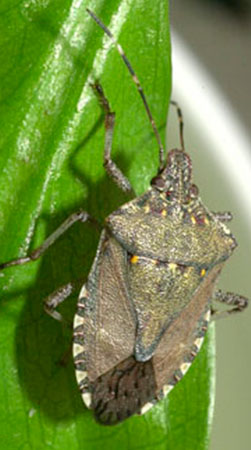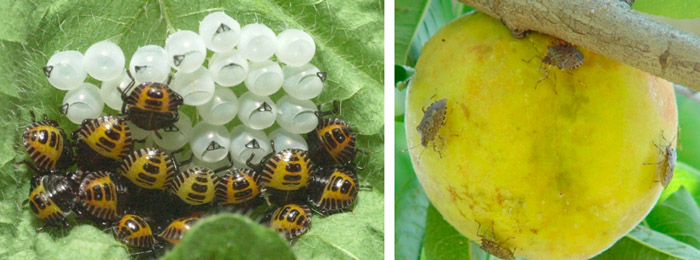Issue 12, July 16, 2010
Brown Marmorated Stink Bug: Know This Invasive!
The Brown Marmorated Stink Bug (Halyomorpha halys) is native to Asia but has been transported to the United States and found in many states in the eastern U.S. Its presence in Illinois is unknown. The presence of these bugs is a concern because they can cause injury to a variety of crops and ornamentals including but not limited to pear, peach, mulberry, persimmon and apple trees, as well as soybeans and various shade trees. This stink bug will pierce and feed on plant stems and fruit leaving wounds that destroy commercial and aesthetic value of the plants. Another concern is that this stink bug will often infest buildings in the fall in order to overwinter, becoming a nuisance to home and business owners.

Adult Brown Marmorated Stink Bug (Photo courtesy Invasive.org)
The Brown Marmorated Stink Bug mates in the spring; and females will lay multiple clusters of eggs. Each cluster has 20-30 eggs, and the total number of eggs laid per female, per season, is about 400 eggs. These egg clusters are deposited on host plants such as the aforementioned crops, fruit trees, and ornamentals. After the eggs are laid, it only takes 4 or 5 days for the nymphs to emerge. Adults will feed on host plants before seeking overwintering locations in the fall (usually houses or other buildings) where they will remain until the spring when mating once again occurs.

Brown Marmorated Stink Bug Nymphs Hatching (left); Brown Marmorated Stink Bugs Feeding on Fruit (right) (Photos courtesy Invasive.org)
The Brown Marmorated Stink bug is similar in shape and size to a variety of native insects including the brown stink bug, assassin bug, and squash bug. Like many of these insects, this stink bug grows to just over half an inch in length and its body has a flattened shield shape. The characteristics that set it apart from other insects are the white banding on the antennae, the distinctive pattern on the edge of its wings, and its red eyes. For a more detailed comparison of the brown marmorated stink bug and look-alikes, you can check out this fact sheet (Adobe PDF).--Irenka Carney and Kelly Estes
Author:
Kelly Estes